Table of Contents
Explore Blogs
Trending on Ebook
Title Capitalization Rules: Know Which Words to Capitalize

Capitalization rules in English might seem easy at first, just like some tricky verbs and phrases. But actually, they can be quite complicated. Why? Because there isn’t one rule that everyone follows for capitalizing words. Surprising, isn’t it? It would be fantastic if all styles followed the same capitalization rules.
As writers, you must proofread your manuscripts to make them grammatically free, but what most writers forget to notice is what you capitalize in a title. This applies not just to book titles but also, among other things, to blog headers, email headlines, chapter titles, and subtitles.
While yes you might be following major style guides like AP Stylebook, the Chicago Manual of Style, and the American Medical Association Manual of Style – even after this, you must follow standard title capitalization rules. Don’t know what they are? Worry not because I have broken them down for your understanding.
Key Takeaways
- Title capitalization rules may vary with different writing style guidelines.
- Always capitalize the first word and the last word of the title.
- Always capitalize nouns, adjectives, adverbs, and verbs.
- If the article is the first or the last word of the title, it will be in uppercase.
- Don’t capitalize articles (unless it’s the first word of the title) and conjunctions.
- Capitalize historical periods and specific events.
- Always capitalize “I” as a pronoun.
- Capitalize family relationships when used as proper nouns.
- Always capitalize days, months, and holidays.
- Major words should be capitalized.
- Capitalize minor words unless they are the first or last word in the title.
What Should Be Capitalized in a Title: Rules You Must Know
1. The First and Last World Should Be Capitalize
So, let’s start with a very basic capitalization rule: the first and last words of titles should always be capitalized, which is the simplest guideline you can stay true to with 100% assurance.
This guideline is accepted by all style guides since it is logical. You may visually indicate to the reader where the title starts and finishes by capitalizing the initial and last words. Even if it is used in a longer sentence, it cannot be confused with the surrounding text.
Note: The format of words that are capitalized to make a title is known as “headline case” or “title case.” This is not the same as “sentence case,” which is what this paragraph is about.
Example:
- Wrong: this Sentence is Capitalized correctly.
- Right: This Sentence Is Capitalized Correctly.
2. Make the First Word of Sub-Titles Capitalize, Too!
The rule for subtitles is rather straightforward: the first word in the subtitle should always be capitalized. Subtitles, which come after a colon, are very common in academic and factual literature.
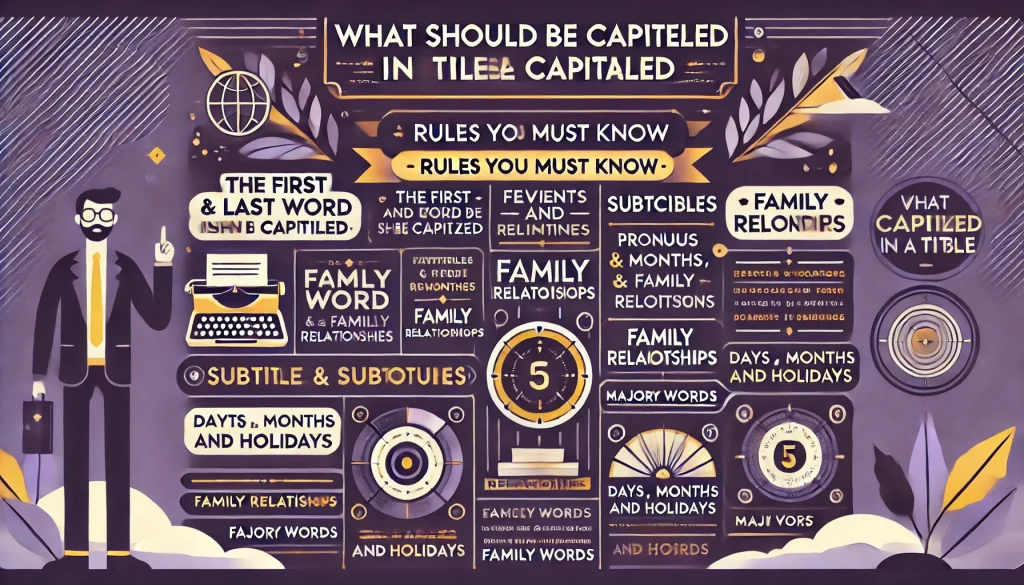
You may breathe a sigh of relief if you’re concerned about the style guide of choice for your organization. One of the rules where the MLA, APA, AP, and Chicago style guides all agree beautifully is to capitalize the initial word of a subtitle.
Examples:
- Michelle Obama’s memoir Becoming: A Guided Journey Through Her Life
- Sapiens: A Brief History of Humankind
- The Sixth Extinction: An Unnatural History
3. Put Events and Timings in Capital Letters
Periods, historical periods, and specific events all must be capitalized.
Example:
- Wrong: Lessons from the vietnam War
- Right: Lessons From the Vietnam War
4. “I” Should Be Capitalized as a Pronoun
By now, we’re all accustomed to seeing terms like iMac, iPad, and iPhone. The “i” in these terms doesn’t need to be capitalized. If you did, it wouldn’t be grammatically proper and would appear weird. However, “I” should always be capitalized if it is a pronoun.
Example:
- Wrong: i Enjoy Using My iPhone for Work
- Right: I Enjoy Using My iPhone for Work
5. Capitalize Family Relationships
When you use a word to indicate a family relationship, it should be capitalized if it’s used as a proper noun.
Example:
- Uncle Micheal
- Grandpa
6. Capitalize the Days, Months, and Holidays
Months, days, and holidays are all considered proper nouns. Therefore, they need to be capitalized.
Example:
- Wrong: christmas celebrations in december
- Right: Christmas Celebrations in December
7. Capitalize Major words
All major style guides use essentially the same major and minor terms. What changes is whether or not you uppercase them. However, as a general guideline, it’s helpful to note that capitalization is appropriate for significant words and not for little ones.
- Major Words: Words containing four or more letters, adjectives, pronouns, adverbs, nouns, and verbs.
- Minor Words: Conjunctions, articles, words of three or fewer words, and brief prepositions.
Capitalization Rules for Parts of Speech in Titles
1. Nouns and Pronouns
A name for a person, location, or object is called a proper noun. These nouns should always be capitalized regardless of where they appear in a phrase. Companies, nations, cities, religions, and political parties are examples of proper nouns, but they are not the only ones.
Capitalization is also required for names. It includes first name, middle, and last names. Most style guidelines agree that pronouns and nouns should always be capitalized in the title case, so formatting them is simple.
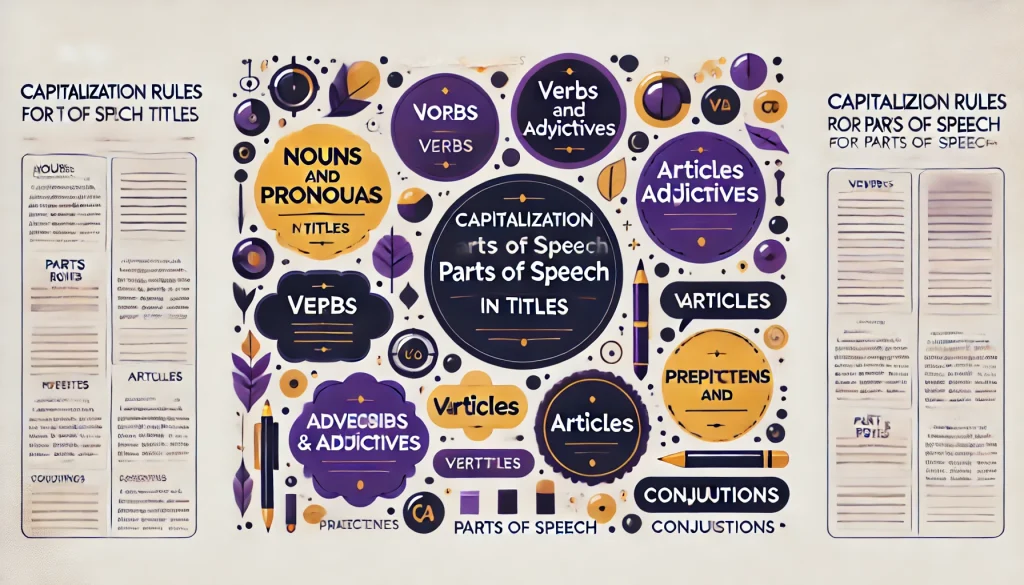
Pro Tip: Even if you omit a person’s name, you should uppercase their title if you are speaking to them directly, such as “Judge” or “Doctor.”
Example 1:
- Wrong: A trip to new york City
- Right: A trip to New York City
Example 2:
- Wrong: The fault in our Stars
- Right: The Fault in Our Stars
- Here: Fault and New York – noun, Our – pronoun
2. Capitalization Rules for Verbs
Verbs are another basic case in point and are always capitalized as per all style rules. So, whenever you use the verb in the title, make sure to capitalize it make sure to uppercase it.
Example 1:
- Wrong: The World as I see It is a book by Albert Einstein
- Right: The World as I See It is a book by Albert Einstein.
Example 2:
- Wrong: Things fall Apart is by Chinua Achebe.
- Right: Things Fall Apart is by Chinua Achebe.
3. Adverbs and Adjectives
Adjectives and adverbs follow the same capitalization rules as nouns. Therefore, there are no issues with them.
Example 1:
- Wrong: A Scanner darkly
- Right: A Scanner Darkly
Example 2:
- Wrong: Stephen King wrote the long Walk in 1979
- Right: Stephen King wrote the Long Walk in 1979
- Here: Darkly – adverb, Long – adjective
4. Capitalization Rules for Articles
The article should be in lowercase, according to all style standards, unless it’s the first or last word in the title. The guidelines for articles are simple
Example 1:
- Wrong: the Lord of the Rings
- Right: The Lord of the Rings
Example 2:
- Wrong: Harry Potter and The Chamber of Secrets
- Right: Harry Potter and the Chamber of Secrets
Here, “the” in the first example is the first word in the title, so it has to be capitalized, while “the” in the second example should be in lowercase as usual. The same rule would be applied to sub-titles as well.
5. Prepositions
Your choice of style guide will also determine whether or not you capitalize prepositions.
- AP Title Case: Prepositions of at least four characters, including between, above, and below, should be capitalized.
- Chicago Manual of Style: All prepositions, regardless of length, should be capitalized.
Pay attention to how you use a preposition in a title while using Chicago Style; it may not always serve as a preposition. According to the Chicago Manual of Style, a preposition can be capitalized if it is “used adjectivally or adverbially, like “up” in Look Up and “down” in Turn Down.
Example 1:
- Chicago Style: Love in the Time of Cholera.
- AP Style: Love In the Time of Cholera.
Example 2:
- Chicago Style: Norman Maclean wrote A River Runs through It.
- AP Style: Norman Maclean wrote A River Runs Through It.
6. Capitalization Rules for Conjunctions
The situation with conjunctions is a little more complex because different style guides have different opinions on whether or not to uppercase them.
Some rules state that larger conjunctions should be capitalized, whereas those with three letters or less should be written in lowercase. However, some style guidelines specify that all conjunctions should be written in lowercase, or they offer an exemption for certain conjunctions such as “so,” “as,” and “yet.”
Therefore, before submitting an article, it is always vital to research the particular guidelines of the target publication. For more information, Read the next section on different style guides. Nonetheless, the instances that follow are very universal:
Example 1:
- Wrong: The Lion, the Witch, And the Wardrobe
- Right: The Lion, the Witch, and the Wardrobe
Example 2:
- Wrong: The Lord Of the Rings
- Right: The Lord of the Rings
If you’re not sure of your exact title, it’s better to check the rule of style.
Title Capitalization Rules for Some Common Words
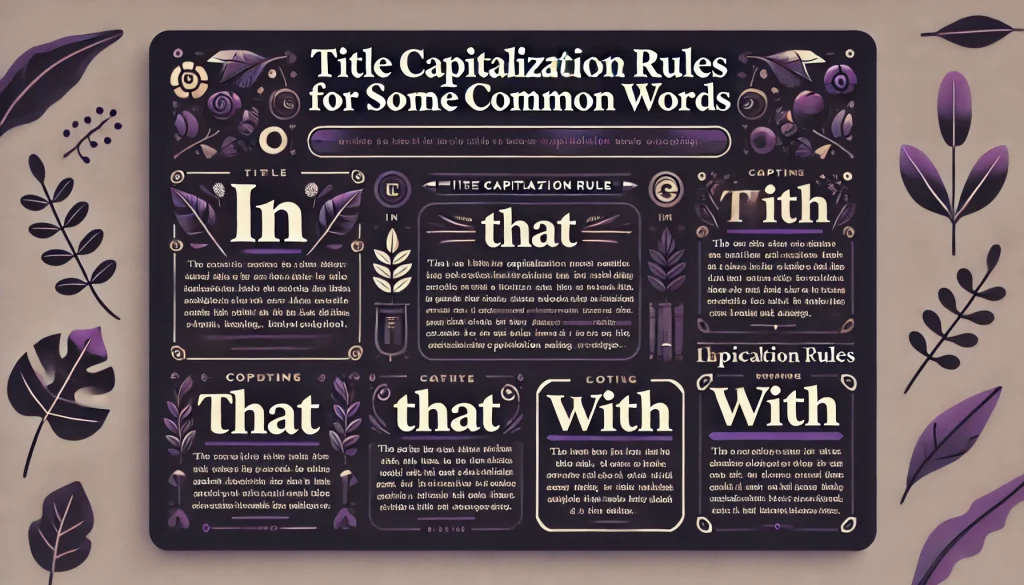
For most individuals, capitalization is merely a matter of a few words. Words like “on,” “in,” “that,” and a few more might cause us to make mistakes and start doubting ourselves. So, let’s find to be sure if these words should be capitalized in a title.
“in”
The subheading above could make it clear to you that “in” is not usually capitalized in titles. There are certain exceptions to this rule, though.
The word should be capitalized, whether it appears at the start or finish of the title.
Examples:
- In the Mouth of Madness
- Time to Go In
Since “in” is considered a minor word in all style guides, it is often not capitalized. It would be capitalized if it were the first part of a hyphenated phrase, like “In-Time.”
Remember…
If you’re using the AP style standard, “In-Time” would be “In-time.”
“that”
According to all major style guides, “that” in a title should be capitalized. Whether it is at the beginning or the end of your title, hyphenated or not, “that” must always be capitalized!
The word “that” is crucial because its meaning may change based on how and when it is used. Every keyword in a title has to be capitalized.
Additionally, its length of four letters surpasses the three-letter rule of thumb used by many style guides to establish title capitalization.
Example:
- Wrong: The Book that Changed My Life
- Right: The Book That Changed My Life
“with”
The word “with” in titles often confuses. Half the time, it has to be in uppercase, and in some cases, it should be in lowercase. Whether to capitalize “with” in a title relies on a number of variables.
According to the AMA, NYT, Associated Press (AP), and APA style standards, propositions that contain four or more letters must always be capitalized. “With” should always be capitalized if you’re following any of those styles.
Different Style Guides and Their Capitalization Rules
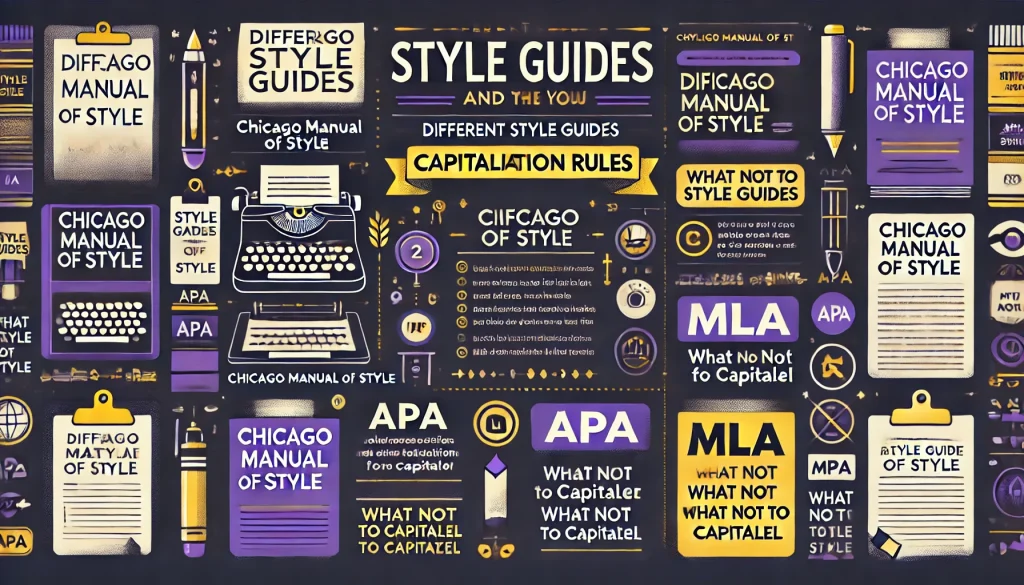
If you are writing for a particular organization, make sure to bookmark their style guide. These style guides help clarify what words should not be capitalized in a title and which ones should be. Here are the requirements for appropriately capitalizing titles from the four most widely used style guides for your convenience:
1. Chicago Manual of Style
Capitalize:
- The title’s initial and final words.
- Adjectives, nouns, pronouns, verbs, and adverbs.
- Conjunctions that subordinate.
Don’t Capitalize:
- Articles, any length of a preposition.
- Coordinating conjunction like “To,” if it is employed in an infinitive
For example: Journey to the Center of the Earth.
2. APA – American Psychological Association Publication Manual
Capitalize:
- Title’s initial and last words.
- Adjectives, nouns, pronouns, verbs, and adverbs.
- Words with up to four letters, including prepositions and conjunctions.
Don’t Capitalize:
- Words with less than four letters.
- “To”, If utilized as an infinitive
3. MLA- Modern Languages Association Handbook
Capitalize:
- The title’s initial and final words
- Adjectives, nouns, pronouns, verbs, and adverbs
- Conjunctions that subordinate
Don’t Capitalize:
- Articles, long and short prepositions, and the coordinating conjunction
- “To,” if it is used in an infinitive
4. AP – The Associated Press Stylebook
Capitalize:
- The title’s initial and final words
- Adjectives, nouns, pronouns, verbs, and adverbs
- Conjunctions that subordinate
- Words with more than four letters, including conjunctions and prepositions that begin with
- “To,” when treated as infinitives
For Example: Failure To Launch
What Should Not be Capitalize:
- Prepositions and articles with less than four letters
- Conjunctions that coordinate
Useful Tips for Title Capitalization
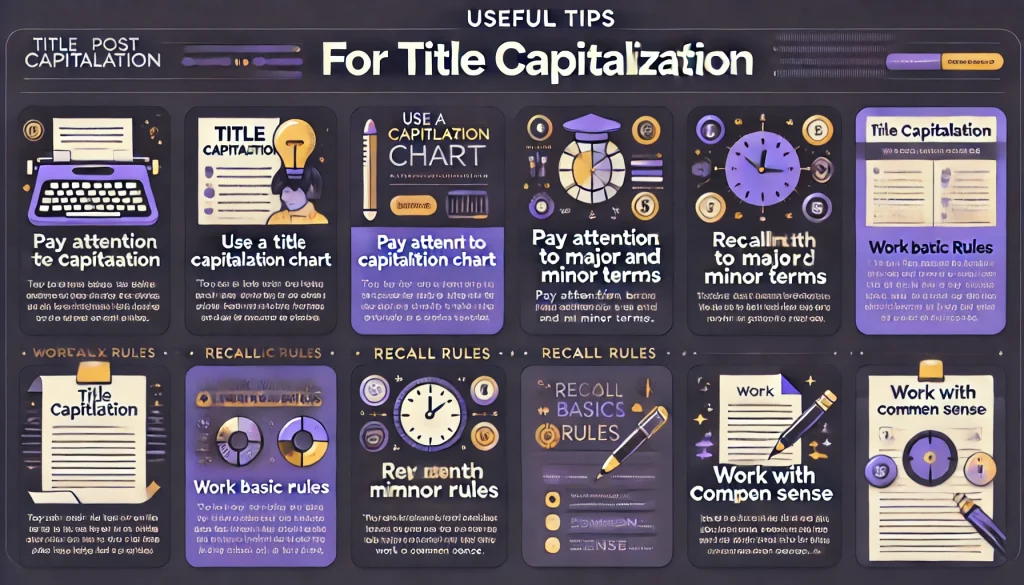
It might be challenging to recall which terms need capitalization. Fortunately, several useful tips help writers remember what words to capitalize.
-
Make Use of a Visual or Capitalization Chart
Information may be well remembered with visual aids. Authors can easily recall which words to uppercase by using a capitalization chart. Having a paper copy on hand is the key. Computer-stored digital charts aren’t always viewable.
-
Pay Attention to Both Major and Small Terms
Meaningful words are referred to as “major” words. The words that connect the big words are called “minor” words. Using this tool might help you recall the capitalization requirements for titles.
-
Recall the Basic Rules
The first and last words of a title are easy to remember to capitalize. The words an, the, to, an, to, about, and with are also commonly used in titles but are not capitalized. Popular words that don’t require capitalization are sometimes better committed to memory.
-
Work With Common Sense
Over time, figuring out which words require capitalization becomes easier. If the capitalization of a title appears incorrect, there is most likely a mistake.
Wrap Up
We hope that this guide has cleared up some of the uncertainty surrounding what should be capitalized in a title, even though properly capitalizing your own title may be challenging. While most of the guidelines are quite simple, other style guides have different standards (such as how prepositions should be capitalized). Be sure to choose the appropriate style guide.
FAQs
I) What are the title capitalization rules for hyphenated words?
Normally, hyphenated words are capitalized on both portions when a hyphenated phrase, a preposition, a conjunction, or any other minor word, just the first part of the phrase is capitalized.
II) What about titles with quotes and other punctuation?
When using commas, punctuation, or quotes in a title, follow the conventional capitalization guidelines.
For example, The ‘Great Gatsby’ in American Literature
In this, “The” and “Gatsby” is capitalized while “in” is not.
III) What are the standard capitalization rules for titles?
Standard capitalization includes the first and last words of a title, nouns, pronouns, verbs, adjectives, and the first word of any subtitle. However, conjunctions, articles, and all other minor words should be in lowercase unless they are the first or last word of the title.
IV) Do you capitalize is in a title?
Yes, “is” is typically capitalized in a title. According to most title capitalization styles, including AP, Chicago, and MLA, all verbs—regardless of their length—should be capitalized. Since “is” is a verb, it would be capitalized in titles.
V) Is it necessary to capitalize titles correctly?
Yes, it is generally necessary to capitalize titles correctly, especially in formal writing, publishing, and professional contexts. Proper title capitalization improves readability and makes your work appear polished.
VI) Do I need to remember these rules by heart?
No, you don’t have to memorize the capitalization rules or guides. There are online tools for the rescue. Online tools help save time and effort when it comes to capitalizing titles.




